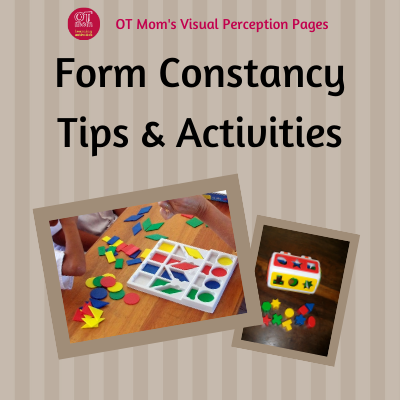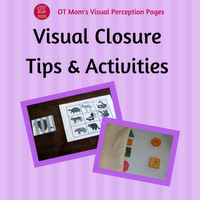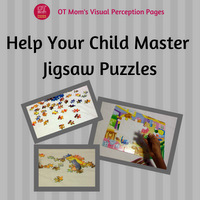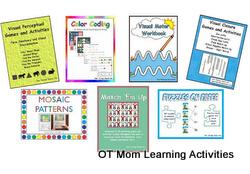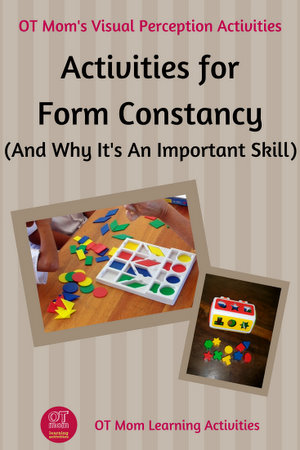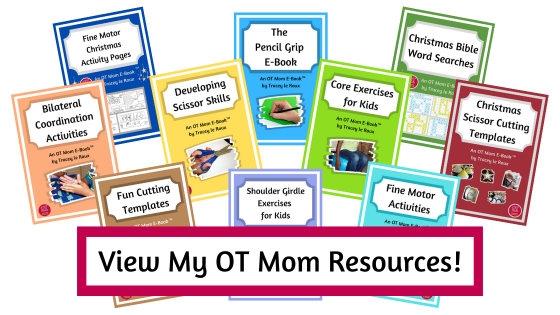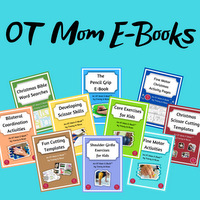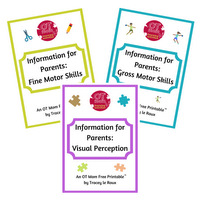- Home Page
- Visual Perception Activities
- Form Constancy
Form Constancy:
Boost Your Child's Skills With Fun Activities
Is a square still a square if it's tilted? Your form constancy skills will tell you "Yes"!
For kids, developing this vital skill means they will be able to recognize shapes, letters and objects even when the size, color or orientation changes.
I sometimes link to products (#Ad) that are similar to those I use and love. If you do purchase something through my links, I will receive a small commission that helps support my site - thank you!
Key Takeaways For Busy Parents:
- Understanding Form Constancy: Kids need this skill in order to recognize objects in different contexts and from different angles.
- Effect Of Poor Skills: Weak skills may cause poor recognition of letters and words in different fonts and contexts.
- Develop Skills Through Play: Simple, playful ideas at home include shape recognition activities, "I Spy" games, and using shopping catalogues.
- Printable Resources: Although hands-on activities are best, use these carefully chosen printables to support development.
These visual perception activities are intended to encourage your child's normal visual perceptual development. If you suspect your child has visual perceptual delays, please seek a professional opinion.
Why Do Kids Need This Skill?
What Form Constancy Is:
Form Constancy refers to the ability to recognize and label objects even when they are viewed from a different angle or in a different environment.
How It Affects Kids:
Kids who struggle with this perceptual skill may not recognize shapes, numbers and letters when the color, size or font changes, or when they are presented in a different context (for example when they see them in the playground instead of in the classroom).
For example, when learning to identify rectangles on a worksheet, they may fail to see that the picture on the wall is in the shape of a rectangle. Or when learning the letter "a" in class, they don't recognize the same letter in a book at home.
There is a difference between this skill and "form perception".
Form Perception is more of a "gestalt" term used by psychologists and artists and refers to our ability to perceive the characteristics of objects (such as rounded and straight edges).
Simple Form Constancy Activities
These activities are suitable for preschoolers. First make sure your child understands what makes a shape special (eg a circle is round; a triangle has 3 corners). For very young children, introduce just one shape at a time - conventional wisdom says one shape a week!
- Touch Discrimination Activity
Have a variety of shapes on hand. Cover them and ask your child to feel a shape and tell you what it is without looking. If language skills are poor, they can point to the matching shape on the table.
Increase the challenge by asking your child to find a specific shape.
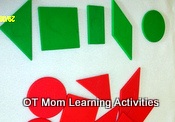 Identify shapes by feel
Identify shapes by feelPattern Blocks#Ad are good shapes to use for this activity. See this page of my site for more tactile discrimination activities.
- Find Shaped Objects In The Home
Ask your child to point out the different objects in your home that are a specific shape (eg a clock may be a circle, a table may be a rectangle).
This child has identified 2 rectangles on the wall.
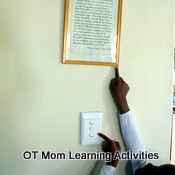 Find shapes in the home
Find shapes in the home - Find Shaped Objects On A Tray
If your child finds it too hard to recognize forms in a busy room, place some household items on a tray and ask your child to pick out specific shapes.
This tray has some triangles and ovals.
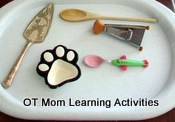 Find shapes on a tray
Find shapes on a tray - Find Shapes In Picture Books
Use picture books and ask your child to find the different shapes in the picture.
You can ask questions like: “show me the circles in this picture” or “what shape is the tabletop?”
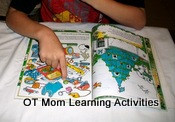 Find shapes in picture books
Find shapes in picture books - Find Shapes In A Shopping Catalog
Use a shopping catalog or magazine, and ask your child to point out objects that are a specific shape.
You could then cut them for your child to paste into a shape notebook. (Older kids can practice their cutting skills and do this for a younger sibling!)
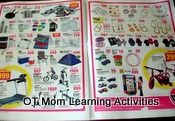 Find shapes in a shopping catalog
Find shapes in a shopping catalogActivities To Reinforce Number and Letter Constancy
- "I Spy" Out and About
Take a walk through town or your neighborhood and let your child spot the current number or letter that they are busy learning.
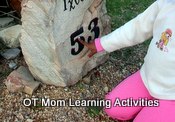 Finding numbers in the neighbourhood
Finding numbers in the neighbourhood - "I Spy" In The Pantry
Let your child raid your pantry, and find the current number or letter on the packaging.
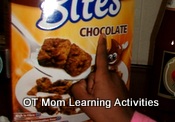 Finding letters on a cereal box
Finding letters on a cereal box - "I Spy" Different Fonts
Let your child look for specific numbers or letters in magazines, catalogs, on your calendar and so on.
Let your child cut them out and paste them into a notebook, or you could cut them out for your younger child if this is too demanding.
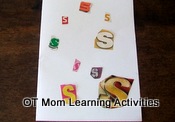 Identify the same letter in different fonts and sizes
Identify the same letter in different fonts and sizesForm Constancy Worksheets
Although I prefer hands-on activities to boost visual perception skills, especially in the preschool years, there is a place for well chosen worksheets to help promote the skills you are working on with your child.
Most worksheets are labelled "visual perception skills" without being specific - so here is what to look for in order to boost form constancy skills.
Look for worksheets that require the child to find objects that are the same even though viewed from a different perspective.
This worksheet requires the child to find the same shoe, viewed from different perspectives.
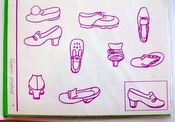 Identify the same object from different perspectives
Identify the same object from different perspectivesLook for worksheets require the child to identify shapes even when they are different sizes, colors or orientations.
Worksheets that ask the child to find the shape in everyday objects are also good (eg clocks and wheels are circles; picture frames
and books are rectangles).
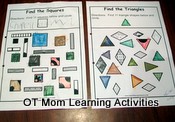 Find all the specified shapes
Find all the specified shapesAt the beginning, avoid worksheets that have overlapping shapes, as these require additional visual perception skills such as figure-ground perception, and can be confusing for kids who struggle.
There are some form constancy worksheets in this Visual Perceptual Games and Activities workbook - I use this resource often!
Additional Resources
These other pages on my site give lots of visual perception activity ideas and resources to build your child's skills. Have fun!
There is sometimes a place for desktop worksheet activities in preschool, although I prefer to use worksheets as little as possible at this age.
You can check out my favorite printable visual perceptual worksheets for preschoolers on this page of my site!
As you can see, simple, playful activities with everyday objects are the best way to strengthen your child's visual skills. Turning learning into a game can help your child develop confidence in recognizing shapes, letters and numbers in any context.
Read my page on Visual Perceptual Skills to learn more about how visual skills can affect a child's learning.
Sign up for my free, occasional newsletter to get a FREE Visual Perception Info Sheet, and to keep in touch with new pages and activities on my site!
- Home Page
- Visual Perception Activities
- Form Constancy
Share this page to help others!
Didn't find what you were looking for? Try a search of my site!
